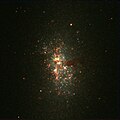NGC 5253
| Galaxy NGC 5253 |
|
|---|---|

|
|
| Photo from the Hubble Space Telescope | |
| AladinLite | |
| Constellation | centaur |
|
Position equinox : J2000.0 , epoch : J2000.0 |
|
| Right ascension | 13 h 39 m 55.9 s |
| declination | -31 ° 38 ′ 24 ″ |
| Appearance | |
| Morphological type | Im / pec / HII / Sbrst |
| Brightness (visual) | 10.1 mag |
| Brightness (B-band) | 11.0 mag |
| Angular expansion | 5 ′ × 1.9 ′ |
| Position angle | 45 ° |
| Surface brightness | 12.4 mag / arcmin² |
| Physical data | |
| Affiliation | M83 group |
| Redshift | (+1358 ± 10) · 10 −6 |
| Radial velocity | +407 ± 3 km / s |
|
Stroke distance v rad / H 0 |
(12 ± 1) x 10 6 ly (3.75 ± 0.28) Mpc |
| history | |
| discovery | Wilhelm Herschel |
| Discovery date | March 15, 1787 |
| Catalog names | |
| NGC 5253 • UGC A 369 • PGC 48334 • ESO 445-G004 • MCG -05-32-060 • IRAS 13370-3123 • 2MASX J13395599-3138241 • GC 3620 • H II 638 • h 3526 • AM 1337-312 • Dun 623 • LDCE 0993 NED007 | |
NGC 5253 is an irregular galaxy of Hubble type in the constellation Centaurus the southern sky . It is an estimated 12 million light years from the Milky Way and is classified as a starburst galaxy .
In 1972 the type Ia supernova SN 1972E was observed here.
The object was discovered by Wilhelm Herschel on March 15, 1787 .
Superimposition of images from the Hubble space telescope (blue: 550 nm, green: 790 nm) and from the VLT (red: 2160 nm)
Web links
- ESO: Big Stellar Clusters Forming in the Blue Dwarf Galaxy NGC 5253 November 18, 2004
- astronews.com: Picture of the day November 26, 2012
- NGC 5253. SIMBAD, accessed February 8, 2016 .
- NGC 5253. DSO Browser, accessed February 8, 2016 .


